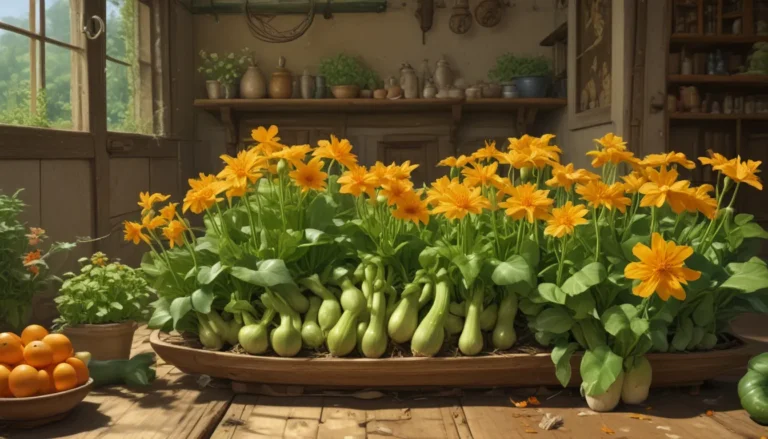The Ultimate Guide to Growing and Caring for Bridalwreath Spirea

Are you dreaming of adding a touch of elegance and charm to your garden? Look no further than the bridalwreath spirea. This flamboyantly ornamental shrub is a sight to behold, with its frothy fountains of pretty flowers in mid-spring.
The masses of small, double-petaled white blossoms cover the arching or upright branches, creating flowing, flowering streams that are sure to catch anyone’s eye. Not to mention, the light fragrance of the rose-like blooms invites a variety of helpful pollinators, making it a treat for your garden ecosystem.
But the beauty doesn’t stop there. Before the flowers fade, the fetching leaves emerge, adding cool tones to your summer garden. And as fall rolls around, these leaves transform into rich shades of burgundy, gold, orange, plum, and scarlet, ensuring you have something to admire all year round.
If you’re ready to welcome this hardworking shrub into your garden, let’s dive into everything you need to know to grow and care for bridalwreath spirea!
What Is Bridalwreath Spirea?
Bridalwreath spirea, scientifically known as Spiraea prunifolia, is a native species to temperate regions of China, Japan, Korea, and Taiwan. This deciduous clumping shrub boasts an upright growth habit with elegant, arching canes that make it a standout in any landscape.
But the term “bridalwreath” isn’t just about its appearance. It’s a nod to the long, twisting sprays of flowers that were traditionally fashioned into wreaths worn during special occasions. The romantic history adds an extra layer of charm to this already delightful shrub.
Cultivation and History
The bridalwreath spirea has a rich history that dates back to the early 19th century when the double-flowered variant of the plant was discovered by Western botanists. This hybrid form became a popular ornamental in Japan and later made its way to Europe and North America.
Despite its popularity, there is some confusion surrounding the naming of the species. The double-flowered variant was mistakenly classified as S. prunifolia, while the true botanical type, with simple, single flowers, became known as S. prunifolia var. simpliciflora.
The ease of cultivation and propagation of bridalwreath spirea has made it a beloved addition to gardens around the world. And contrary to popular belief, it is not considered invasive and is a safe choice for your landscape.
Bridalwreath Spirea Propagation
If you’re looking to propagate bridalwreath spirea, your best bet is through softwood cuttings taken during the growing season. Starting plants from seed may not yield offspring that replicate the characteristics of the parent plant.
Hardwood cuttings and ground layering are also viable options for propagation. Each method offers a unique way to expand your collection of these exquisite shrubs.
To propagate from softwood cuttings, prepare 10-inch segments of pliable stem tips in late spring to midsummer. Remove the lower leaves, dip the cut ends in rooting hormone if desired, and plant them in moist starter soil.
After rooting takes place in about four to six weeks, repot the cuttings into individual containers and provide proper care until they are ready to be planted out in your garden.
How to Grow Bridalwreath Spirea
Growing bridalwreath spirea is a rewarding experience that requires a few key steps to ensure success. Here’s a quick guide on how to get started:
-
Soil and Sunlight: Plant your bridalwreath spirea in well-draining soil with an average fertility level. Aim for a pH of 6.0 to 7.0 and a location that receives full sun to partial shade.
-
Planting: When planting, make sure to loosen the soil to allow for proper root development. Mix in organic matter and drainage grit if needed, and plant your spirea at the same depth as its nursery pot or a couple of inches below the soil line.
-
Watering: Keep the soil lightly moist for new plants until they become established. Once mature, allow the top two to three inches of soil to dry out between waterings.
-
Pruning: Prune your bridalwreath spirea after flowering to maintain its size and shape. Avoid cutting back during dormancy to preserve flower production.
-
Fertilizing: Apply compost or slow-release fertilizer in early spring to promote healthy growth. New plants may benefit from a protective layer of mulch to shield the roots from extreme temperatures.
Growing Tips
To ensure your bridalwreath spirea thrives and remains a focal point in your garden, consider these helpful tips:
-
Sunlight: While bridalwreath spirea can tolerate partial shade, it blooms more profusely and displays brighter fall foliage colors when planted in full sunlight.
-
Soil: Provide well-draining soil with a pH of 6.0 to 7.0 to support healthy growth.
-
Watering: Container plants may require more frequent watering than those planted in the ground. Monitor soil moisture levels and water when the top two inches of soil are dry.
Pruning and Maintenance
Proper pruning and maintenance are key to keeping your bridalwreath spirea healthy and attractive. Here are some tips to follow:
-
Regular Pruning: Prune after flowering to maintain the plant’s form and size. Avoid shaping or resizing while the plant is dormant to prevent flower loss.
-
Deadheading: Remove faded flowers with clean, sharp shears to promote new growth and tidy up the plant.
-
Feeding: Apply compost or slow-release fertilizer in early spring to provide essential nutrients for healthy growth.
-
Winter Care: Mulch around the base of new plants to protect them from freeze-thaw cycles and ensure they survive the winter.
Bridalwreath Species and Cultivars to Select
With a wide range of bridalwreath cultivars available, you have plenty of options to choose from for your garden. Here are some popular choices to consider:
Old Fashioned
-
Description: Features graceful, arching branches covered in double white flowers in early spring. Displays vibrant fall foliage in shades of crimson, orange, purple, and yellow.
-
Height: 5-9 feet
-
Spread: 6-8 feet
-
Hardiness Zones: 4-7
Reeves
-
Description: Long, arching branches adorned with clusters of double white blooms. Dark green leaves transition to shades of burgundy, gold, red, and yellow in the fall.
-
Height: 5-6 feet
-
Spread: 4-6 feet
-
Hardiness Zones: 4-9
Renaissance
-
Description: Fountain-shaped shrub with masses of tiny white double flowers. Blue-green foliage turns to shades of orange, red, and purple in the fall.
-
Height: 5-7 feet
-
Spread: 6-8 feet
-
Hardiness Zones: 3-7
Vanhoutte
-
Description: Laden with small double white flowers on graceful, arching branches. Vase-like form with blue-green foliage that transforms to burgundy or purple in the fall.
-
Height: Up to 8 feet
-
Spread: 6 feet
-
Hardiness Zones: 3-8
Each cultivar offers its unique beauty and characteristics, allowing you to select the perfect bridalwreath spirea for your garden.
Managing Pests and Disease
While bridalwreath spirea is generally resilient against pests and diseases, it can be vulnerable to some common issues. Here are a few to watch out for:
-
Aphids: Small sapsuckers that feed on leaves and stems, causing yellowing and stunted growth. Use water or insecticidal soap to control infestations.
-
Spider Mites: Tiny pests that thrive in hot, dry conditions and cause spotting and leaf drop. Spray with water or insecticidal soap for effective control.
-
Fire Blight: Bacterial disease that results in stem cankers. Prune out infected wood and disinfect tools to prevent the spread of the disease.
-
Powdery Mildew: Fungal disease that covers tender growth in fuzzy webs. Plant in full sun and maintain proper airflow to minimize infestations.
By staying vigilant and taking preventive measures, you can protect your bridalwreath spirea from common pests and diseases.
Best Uses for Bridalwreath Spirea
Bridalwreath spirea is a versatile plant that offers a range of uses in your landscape. Consider the following applications:
-
Specimen Plant: Use as a striking focal point in foundations, islands, and mixed shrub beds.
-
Barriers and Hedges: Mass plants to create natural barriers, hedges, and screens for added privacy.
-
Borders and Mass Plantings: Add flowers and fall colors to borders or mass plants to create a vibrant display.
-
Woodland Margins: Dot the woodland margins with bridalwreath spirea for a touch of elegance.
No matter how you choose to use them, bridalwreath spirea is sure to elevate the beauty of your garden with its ornamental value.
Conclusion
Embrace the beauty and elegance of bridalwreath spirea in your garden today. With its stunning flowers, captivating form, and vibrant colors, this hardworking shrub is a true gem for any landscape. Whether used as a specimen plant, barrier, or border, bridalwreath spirea is sure to impress with its three seasons of interest.
By following the tips and guidelines provided in this comprehensive guide, you can ensure your bridalwreath spirea thrives and remains a showstopper in your garden. So, go ahead, tie the knot with bridalwreath spirea and enjoy the beauty it brings to your outdoor space!
How do you plan to incorporate bridalwreath spirea into your landscape? Share your ideas in the comments below!
For more information on spirea and other related topics, check out these helpful guides:
- 9 of the Best Types of Spirea Shrubs for Your Garden
- How to Grow and Care for Japanese Spirea
- How to Grow and Care for Birchleaf Spirea Shrubs
With these resources at your fingertips, you’ll be well-equipped to grow and care for your bridalwreath spirea with confidence.
So why wait? Start transforming your garden with the enchanting beauty of bridalwreath spirea today!
Incorporating bridalwreath spirea into your garden is a delightful experience that offers a range of benefits. From its elegant form and stunning flowers to its vibrant fall colors, this charming shrub is sure to captivate all who behold it. With the right care and attention, you can enjoy the beauty of bridalwreath spirea year-round and create a landscape that is truly a sight to behold. So, follow the tips and guidelines outlined in this guide, and start cultivating your own bridalwreath spirea garden today!





